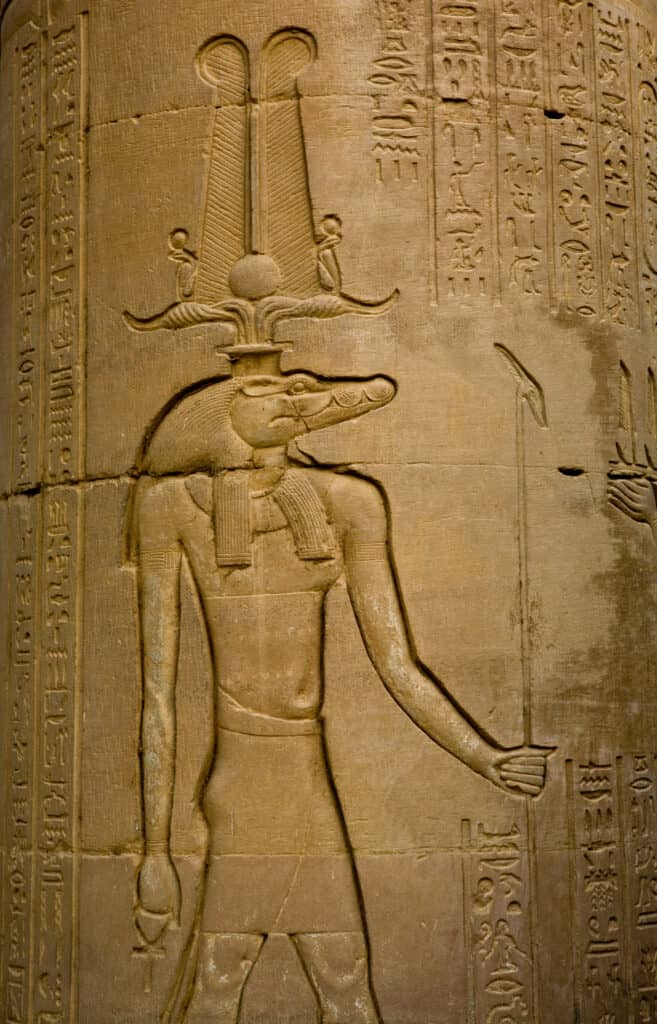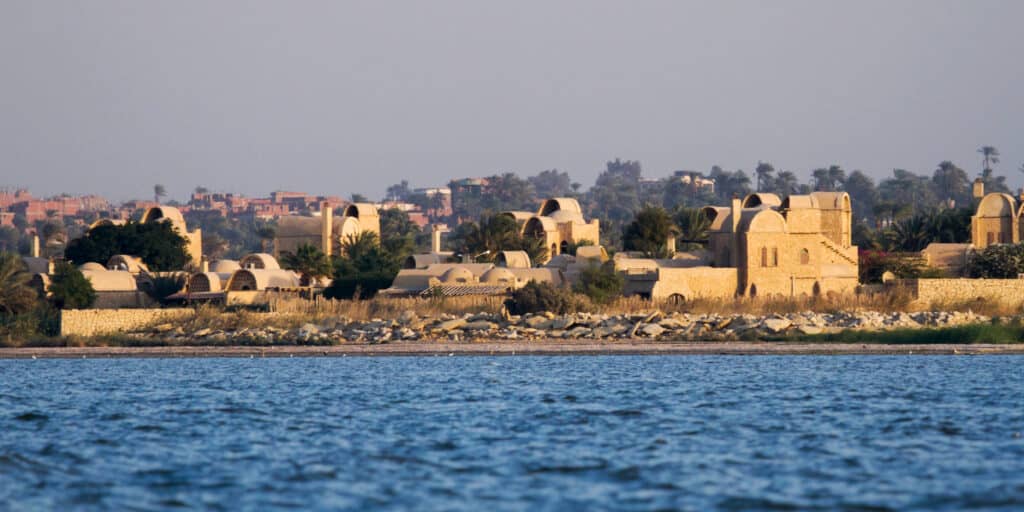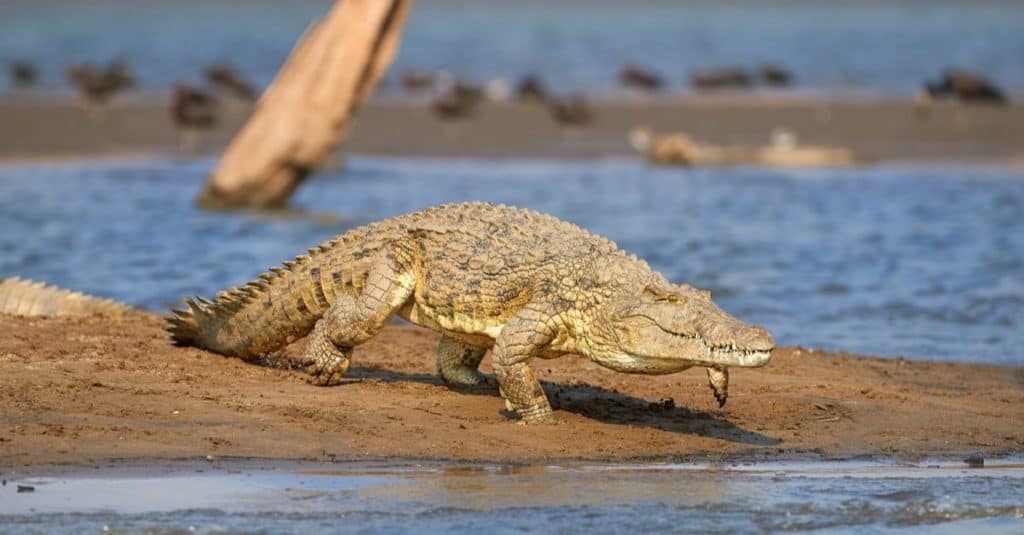Living in the middle of a scorching hot desert, the ancient Egyptians relied almost entirely on the Nile River and its many waterways in order to survive. Although it was revered as the source of life, the Nile was not without its dangers, like hippopotamuses, cobras, and crocodiles. Crocodiles in particular were especially terrifying, as they could be silent and swift in their violence and stealthy hunting.
Sobek, the ancient Egyptian crocodile god, ruled over the Nile, acting as its protector. This made Sobek an extremely powerful and revered god, as well as a terrifying one. To appease and placate the god as they asked for his protection, the ancient Egyptians built a temple to Sobek, complete with real life crocodiles! Read on to discover the city that worshipped crocodiles and covered them in gold and jewelry!
Sobek the Crocodile God

Sobek was the revered Crocodile god of ancient
Egypt
.
©iStock.com/WHPics
The ancient Egyptian crocodile god, Sobek, was the divine ruler and fearless protector of the Nile River. Egyptians both feared and respected him. At times, Sobek is depicted as a crocodile, while other images show him as a man with a crocodile head. He was first mentioned in a pyramid text from the Old Kingdom, making him one of the oldest of the gods.
In some of the Egyptian creation myths, sweat from Sobek’s body formed the Nile. The river provided water to the people in the middle of the desert. But it was also filled with many dangerous animals. Sobek had the power to rule over the Nile and all the dangerous animals in it, which meant that he himself was an utterly powerful being. Sobek was unpredictable and aggressive, but he was not an evil god. He was driven by instinct, much like the crocodiles of Egypt.
Living along the Nile River, ancient Egyptians needed the river to flood each year in order to spread fertile soil and fill the waterways. The Egyptians worshipped Sobek as the ruler and protector of the Nile and its dangerous creatures, and as a god of fertility and growth. The people continuously gave offerings to Sobek, hoping that the god would provide them with enough flooding to nourish their crops.
Crocodilopolis: The Sacred Crocodile City

The City of Crocodilopolis was located near present-day Faiyum, an Egyptian city located in the Faiyum Oasis.
©Abdelrahman Hassanein/Shutterstock.com
Sobek was so revered that Egyptians not only built temples in his name — they dedicated an entire city to him! When the Greeks saw the ancient Egyptian city of Shedet, they called it “Krokodilopolis” or “Crocodilopolis,” which means “The Crocodile City”. Crocodilopolis was the largest and most significant center of worship for the god Sobek. Today it is called Faiyum, located to the west of the Nile River in the Faiyum Region of Egypt.
The location of Crocodilopolis was very strategic. It allowed the people to control many of the small waterways that connected to the main canal and the Nile River. The region was known as one of the most fertile places in Egypt. Egyptians grew anything from vegetables and cereals to figs, dates, roses, gardens, and even vineyards here. There were several lakes in the region with aquatic wildlife, including many crocodiles. At various times in ancient Egypt’s history tourists would come to see the crocodiles, and even feed them!
As strange as it may sound to us today, some Egyptians even kept crocodiles at their homes as house pets! They believed that feeding a crocodile was like making an offering to Sobek and the god would bless them. Generally, Egyptians only kept West African crocodiles as pets, since they are smaller and not nearly as aggressive as the killer Nile crocodiles.
Crocodiles at the Temple of Sobek

Large Nile crocodiles, as well as the smaller West African crocodiles, were both feared and honored by ancient Egyptians.
©Martin Mecnarowski/Shutterstock.com
Crocodilopolis was built in an area dependent on irrigation, so it makes sense that a god of water and fertility would be very important to its people. So, they built a large temple in the center of the city to honor the crocodile god Sobek. The most unique aspect of this temple, however, was its most prized resident –– a living crocodile that lived on the temple grounds!
The Greek rendition of the crocodile’s name is “Petsuchos”, which means the “son of Sobek”. Petsuchos was worshipped as the living manifestation of Sobek, making it a very sacred creature. The priests even adorned Petsuchos with gold, gems, and jewelry! As the son of Sobek, the crocodile was fed better than many of the people living in the city. They gave it many luxuries like wine, meat, and milk with honey. The priests saw to the crocodile’s needs and let it freely roam among the temple.
The Death of Rebirth of the Sons of Sobek
When Petsuchos died, the priests gathered for a formal ceremony worthy of a Pharoah. They embalmed the crocodile’s body and mummified him, along with his gold and jewels, and entombed him in sacred burial chambers. The crocodile was wrapped with the exact same material that the priests used for human mummies. They also prepared the body with extreme care and careful attention to detail, showing just how important and revered the crocodile was to the people of Crocodilopolis.
According to Greek historians, anyone killed by a crocodile considered to be the Son of Sobek was seen as divine. Thus, these victims were also embalmed and buried in sacred coffins. The priests of the Nile also gave them special funeral rights.
After the death of Petsuchos, the priests selected a new crocodile to take his place. This ensured that there always was a living manifestation of Sobek at the temple of Crocodilopolis. The crypts of this temple are filled with countless mummified crocodiles from centuries of worship!
An interesting element that archeologists discovered is one of the materials used during mummification of one of these crocodiles: papyrus. Priests often stuffed the crocodiles with papyri to help the mummies keep their shape. However, papyrus was not cheap, so they would use pieces that had already been written on and discarded — essentially, ancient Egyptian “scrap paper”. Today crocodile mummies are invaluable to Egyptologists. The papyri inside of them provides insights into the daily life of the ancient Egyptians. Just imagine someone reading your grocery list after it had been mummified inside of a crocodile!
Mummified Crocodiles in Egypt
In addition to visiting the temple and seeing the Son of Sobek crocodile, worshippers also made their own offerings to the god. Many gifted their own mummified crocodiles to the temples when they visited. The votive offering of a little mummified crocodile was meant to serve as an ambassador of sorts into the afterlife – to put in a good word about the worshipper to Sobek.
As you can imagine, acquiring a crocodile for mummification isn’t exactly an easy task. To do so truly was an act of faith. You could easily be injured (or even killed) when attempting to catch one of these enormous and fierce animals. Most Egyptians tried to capture smaller crocodiles, since they were easier to catch and much less dangerous, but there simply were not enough to go around.
Because of this, many of the mummified crocodiles found in ancient Egyptian temples are not actually crocodiles at all! Some of the elaborately mummified remains — wrapped in the shape of a crocodile — are only a piece of a crocodile or a collection of other offerings altogether. The more beautifully wrapped a mummy is, the more likely it is a fake or is not quite whole.
Up Next…
- Why Did the Nile Flood Every Year? Was It a Good Thing?
- Discover All 18 Types of Crocodiles Found Across the World
- 12 Snakes That Live by the Nile
- Discover the Massive Crocodiles that Live in Dens 40 Feet Below the Surface
The photo featured at the top of this post is © takepicsforfun/Shutterstock.com
Sources
- Berkeley News, Available here: https://news.berkeley.edu/2021/03/02/crocodile-mummies/
- Encyclopedia of Ancient Egypt, Available here: https://books.google.com/books?id=-6EJ0G-4jyoC&pg=PA90&dq=crocodilopolis+sobek&hl=en&sa=X&ei=A80KU_X-EeW70AHowoCgBg#v=onepage&q=crocodilopolis%20sobek&f=false
- Hellenica World, Available here: http://www.hellenicaworld.com/Greece/Geo/en/Crocodilopolis.html
Thank you for reading! Have some feedback for us? Contact the AZ Animals editorial team.






